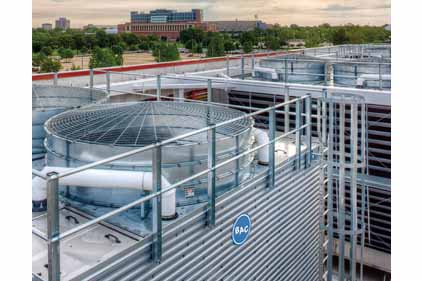 This analysis shows how a water-cooled 500-ton chiller system when compared to a 500-ton air-cooled chiller system results in approximately $45,000 in annual operating costs savings. Additionally, the water-cooled system reduces peak energy demand by 45 percent. The reduction in energy usage and peak demand, especially in HVAC systems, is not just significant for the building owner paying electric bills, but it also helps reduce the stress on the electrical infrastructure and carbon emissions. Lastly, water-cooled systems actually use less water than air-cooled systems since a significant amount of water is used in electricity production. The water usage reduction from lower electricity production more than offsets the water consumed by water-cooled systems.
This analysis shows how a water-cooled 500-ton chiller system when compared to a 500-ton air-cooled chiller system results in approximately $45,000 in annual operating costs savings. Additionally, the water-cooled system reduces peak energy demand by 45 percent. The reduction in energy usage and peak demand, especially in HVAC systems, is not just significant for the building owner paying electric bills, but it also helps reduce the stress on the electrical infrastructure and carbon emissions. Lastly, water-cooled systems actually use less water than air-cooled systems since a significant amount of water is used in electricity production. The water usage reduction from lower electricity production more than offsets the water consumed by water-cooled systems.
Below are the two main methods for heat rejection, air-cooled and water-cooled technology:
• Air-Cooled: A process by which air passes over a coil or channel containing fluid. Heat is transferred from the coil directly to the air.
• Water-Cooled: This process utilizes a spray system to pass water over fill media or coils to reject heat to the atmosphere through evaporation. The spray water itself or the fluid contained in the coil can then be used by a cooling system.
The following analysis compares two 500-ton chiller systems, one with an air-cooled system, and the other with a water-cooled system. A 500-ton system was selected because it is an average size for a typical mid-sized building.
|
Parameter |
Water Cooled System |
Air Cooled System |
|
Chiller Energy Use [Full Load] (kW/ton)2 |
0.6 |
1.255 |
|
Chiller Energy Use [IPLV] (kW/ton)2 |
0.4 |
0.941 |
|
System Capacity (Ton) |
500 |
500 |
|
Average Capacity (Ton) |
290 |
290 |
|
Condenser Pump (HP) |
30 |
--- |
|
Cooling Tower Fan (HP) |
30 |
--- |
|
Filtration System Pump (HP) |
3 |
--- |
|
Hours of Operation [Integrated Part Load Value] |
4,380 |
4,380 |
ASHRAE 90.1 energy usage limits for the two different types of systems were utilized to compare chiller energy usage.
Energy Consumption
|
Parameter |
Water Cooled System |
Air Cooled System |
|
Chiller Energy Usage (kW) |
116 |
273 |
|
Condenser Pump Energy Usage (kW) |
22 |
--- |
|
Fan Energy Usage (kW) |
5 |
--- |
|
Filtration Pump Energy Usage |
2 |
--- |
|
Annual Energy Consumption |
629,937 |
1,195,258 |
|
Peak Energy Demand (kW) |
345 |
628 |
From these limits, you can already see that the water-cooled chiller uses half the amount of energy of the air-cooled system. In addition to the chiller, the water-cooled system must also account for the energy consumption by the cooling tower (fan and pumps). The cooling tower fan is operating on a variable frequency drive (VFD).
The two systems are operating at conditions consistent with those used to calculate the systems integrated part load value (IPLV) efficiency. The IPLV shows the two systems operate at part-load most of the time with a weighted average capacity of 290 tons, for 4,380 hours of operation, the equivalent of half the year.
As you can see with water-cooled technology, annual energy consumption is reduced by 47 percent and the peak energy demand reduced by 45 percent. As seen from the ASHRAE 90.1 chiller energy use standards, the water-cooled system utilizes approximately half the amount of energy of the air-cooled system.
Total Annual Cost Comparison
|
Parameter |
Water Cooled System |
Air Cooled System |
|
Energy Charge |
$ 64,883 |
$ 123,161 |
|
Demand Charge |
$ 4,633 |
$ 8,440 |
|
Total Annual Electricity Cost |
$ 69,517 |
$ 131,601 |
|
Annual Water Cost (4 COC) |
$ 9,186 |
--- |
|
Annual Sewage Cost (4 COC) |
$ 4,047 |
--- |
|
Annual Chemical Treatment Cost |
$ 4,060 |
--- |
|
Total Annual Water Related Costs |
$ 18,332 |
--- |
|
Total Annual Operating Costs |
$87,849 |
$131,601 |
This leads to a savings of $44,500 annually and approximately 33 percent savings on annual operating costs. For the table above, the following assumptions were used:
• Energy Charge: assumed energy cost of $0.103/kWh.
• Demand Charge: $13.44/kW.
• Water Cost ($2.9043/1000 gal): assumed cycles of concentration limited to 4, evaporation rate = CT flow x range x 0.001, and drift rate is 0.002 percent.
• Sewage Cost ($5.3104/1000 gal): bleed rate assumes 4 cycles of concentration.
• Chemical Treatment Cost: ASHRAE 2010 Green Guide’s Green Tip #13 estimates chemical cost range of $8-$20 per ton of cooling annually. An average of $14 per ton of cooling annually was used for this example.
• Average Tons of Cooling = 290, therefore $14 x 290 = $4,060.
• Maintenance cost comparison between the two systems assumed to be equal.
Total Annual Cost Comparison
|
500 Ton System |
Water Cooled System |
Air Cooled System |
|
Equipment and Installation Cost |
$ 64,883 |
$ 123,161 |
|
(One-time cost) |
$ 242,033 |
$ 188,200 |
|
Total Operating Cost (Annual cost) |
$ 87,849 |
$ 131,545 |
The simple payback period in this example is just 1.2 years. Assuming the average system life span of the system is 20 years and inflation is 2.1 percent through 2035, the NPV of total water cooled benefit is approximately $820,000. This savings would be even greater if energy costs continue to climb as expected.
From this and other studies, water-cooled systems are the most energy efficient systems. They not only reduce operating costs and provide a clear financial benefit, but they help protect building owners and operators from uncertainties in electricity pricing. When selecting a cooling system, make sure to do an energy analysis to see which system is best for your application.
Sources:
1. Annual Energy Outlook (DOE/EIA-0383(2011)), International Energy Outlook 2007 (DOE/EIA-0484(2011), Inventory of U.S. Greenhouse Gas Emissions and Sinks: 1990-2009 (April 2011) (EPA 430-R-07-002).
2. Chiller energy use based on ASHRAE 90.1-2013, Table 6.8.1C. Water Cooled based on Path B.
Analysis supplied by Baltimore Aircoil Co. For more information, visit www.baltimoreaircoil.com.
Publication date: 6/9/2014
Want more HVAC industry news and information? Join The NEWS on Facebook, Twitter, and LinkedIn today!








